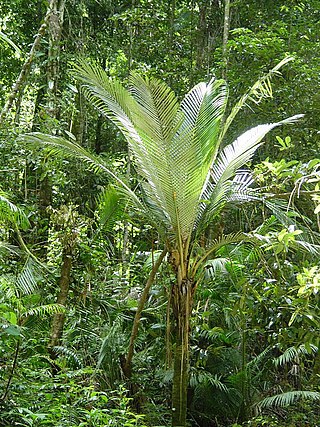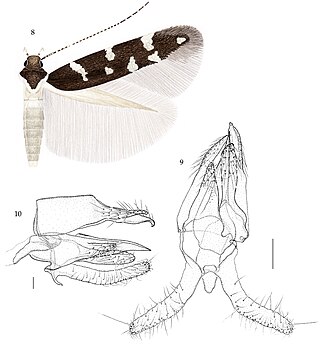
Selenite, satin spar, desert rose, gypsum flower are crystal habit varieties of the mineral gypsum.

In botany, a rosette is a circular arrangement of leaves or of structures resembling leaves.

A leaf miner is any one of numerous species of insects in which the larval stage lives in, and eats, the leaf tissue of plants. The vast majority of leaf-mining insects are moths (Lepidoptera), sawflies, and flies (Diptera). Some beetles also exhibit this behavior.

The South Atlantic Medal is a British campaign medal awarded to British military personnel and civilians for service in the Falklands War of 1982 between the United Kingdom and Argentina. Over 33,000 medals have been awarded. The South Atlantic Medal Association was formed in 1997 for recipients of the South Atlantic Medal.

Oraniopsis is a monotypic genus of flowering plant in the palm family from Queensland, Australia, where the only known species, Oraniopsis appendiculata, grows in mountainous rain forest. Dioecious and extremely slow growing, the name means "similar to Orania" and the Latin epithet translates to "appendaged".

Drosera erythrorhiza, the red ink sundew, is a perennial tuberous species in the carnivorous plant genus Drosera that is endemic to Western Australia. It grows in a rosette and is distinguished from the other species in section Erythrorhiza by its many-flowered cymose inflorescences with up to 50 individual flowers. D. erythrorhiza was first described by John Lindley in his 1839 publication A sketch of the vegetation of the Swan River Colony. In 1992, N. G. Marchant and Allen Lowrie described three new subspecies, thus also creating the autonym D. erythrorhiza subsp. erythrorhiza. The subspecies were separated from this variable species mostly by leaf morphology and distribution.

Vulcaniella is a genus of moths in the family Cosmopterigidae, containing the following species:
Vulcaniella cognatella is a moth of the family Cosmopterigidae. It is found from Ukraine to Sardinia and Greece.
Vulcaniella extremella is a moth of the family Cosmopterigidae. It is found from Poland to the Iberian Peninsula, Italy, and Bulgaria and from France to central and southern Russia.
Vulcaniella fiordalisa is a moth of the family Cosmopterigidae. It is found from Portugal and Morocco, east to the Balkan Peninsula and Lebanon.
Vulcaniella pontica is a moth of the family Cosmopterigidae that is endemic to Turkey.
Vulcaniella grabowiella is a moth of the family Cosmopterigidae. It is found from the Iberian Peninsula to Asia Minor.
Vulcaniella klimeschi is a moth of the family Cosmopterigidae. It can be found in Macedonia, mainland Greece and Crete.
Vulcaniella pomposella is a moth of the family Cosmopterigidae. It is found from France, the Baltic Region and Ukraine to the Mediterranean region.
Vulcaniella rosmarinella is a moth of the family Cosmopterigidae. It is found in the area surrounding the Mediterranean Sea, as far east as Crete. It is also found in North Africa.
Vulcaniella grandiferella is a moth of the family Cosmopterigidae. It is found in Serbia, Macedonia, Greece, Ukraine and southern Russia.

Pinguicula, commonly known as the butterworts, is a genus of carnivorous flowering plants in the family Lentibulariaceae. They use sticky, glandular leaves to lure, trap, and digest insects in order to supplement the poor mineral nutrition they obtain from the environment. Of the roughly 80 currently known species, 13 are native to Europe, 9 to North America, and some to northern Asia. The largest number of species is in South and Central America.
Vulcaniella glaseri is a moth in the family Cosmopterigidae. It was described by Riedl in 1966. It is found in Turkey.

Emaravirus is a genus of negative-strand RNA viruses which infect plants. The plant virus group is the sole genus in the family Fimoviridae. The genus has 21 species.
This page is based on this
Wikipedia article Text is available under the
CC BY-SA 4.0 license; additional terms may apply.
Images, videos and audio are available under their respective licenses.








